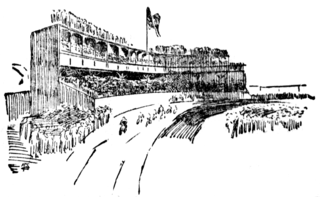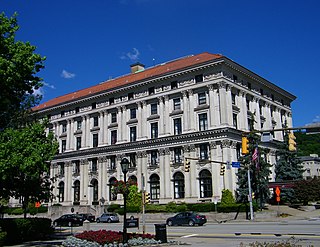Related Research Articles

Pittsburgh is a city in the Commonwealth of Pennsylvania in the United States and the county seat of Allegheny County. A population of 302,971 residents lives within the city limits as of the 2020 US Census, making it the 68th-largest city in the U.S. and the second-most populous city in Pennsylvania, behind Philadelphia. The Pittsburgh metropolitan area is the anchor of Western Pennsylvania; its population of 2.37 million is the largest in both the Ohio Valley and Appalachia, the second-largest in Pennsylvania, and the 27th-largest in the U.S.

The history of Pittsburgh began with centuries of Native American civilization in the modern Pittsburgh region, known as "Dionde:gâ'" in the Seneca language. Eventually, European explorers encountered the strategic confluence where the Allegheny and Monongahela Rivers meet to form the Ohio, which leads to the Mississippi River. The area became a battleground when France and Great Britain fought for control in the 1750s. When the British were victorious, the French ceded control of territories east of the Mississippi.

The University of Pittsburgh (Pitt) is a public state-related research university in Pittsburgh, Pennsylvania. The university is composed of 17 undergraduate and graduate schools and colleges at its urban Pittsburgh campus, home to the university's central administration and 28,391 undergraduate and graduate students. The 132-acre Pittsburgh campus includes various historic buildings that are part of the Schenley Farms Historic District, most notably its 42-story Gothic revival centerpiece, the Cathedral of Learning. Pitt is a member of the Association of American Universities, a selective group of major research universities in North America, and is classified as an R1 University, meaning that it engages in a very high level of research activity. Pitt was the third-largest recipient of federally sponsored health research funding among U.S. universities in 2018 and it is a major recipient of research funding from the National Institutes of Health. According to the National Science Foundation, Pitt spent $1.0 billion on research and development in 2018, ranking it 14th in the nation. It is the second-largest non-government employer in the Pittsburgh metropolitan area. The university also operates four undergraduate branch campuses in Western Pennsylvania, located in Bradford, Greensburg, Johnstown, and Titusville.

Downtown Pittsburgh, colloquially referred to as the Golden Triangle, and officially the Central Business District, is the urban downtown center of Pittsburgh. It is located at the confluence of the Allegheny River and the Monongahela River whose joining forms the Ohio River. The "triangle" is bounded by the two rivers. The area features offices for major corporations such as PNC Bank, U.S. Steel, PPG, Bank of New York Mellon, Heinz, Federated Investors and Alcoa. It is where the fortunes of such industrial barons as Andrew Carnegie, Henry Clay Frick, Henry J. Heinz, Andrew Mellon and George Westinghouse were made. It contains the site where the French fort, Fort Duquesne, once stood.

Allegheny City was a municipality that existed in the U.S. state of Pennsylvania from 1788 until it was annexed by Pittsburgh in 1907. It was located north across the Allegheny River from downtown Pittsburgh, with its southwest border formed by the Ohio River, and is known today as the North Side. The city's waterfront district, along the Allegheny and Ohio rivers, became Pittsburgh's North Shore neighborhood.

Recreation Park was a sporting grounds and stadium located in what is today Pittsburgh, Pennsylvania. The stadium existed during the late 19th and early 20th centuries. During the park's heyday, the location was considered to be within Allegheny City, but in 1907, the entire municipality was annexed by its larger neighbor and eventually became Pittsburgh's North Side.

The economy of Pittsburgh, Pennsylvania is diversified, focused on services, medicine, higher education, tourism, banking, corporate headquarters and high technology. Once the center of the American steel industry, and still known as "The Steel City", today the city of Pittsburgh has no steel mills within its limits, though Pittsburgh-based companies such as US Steel, Ampco Pittsburgh and Allegheny Technologies own several working mills in the Pittsburgh metropolitan area.

The Pittsburgh City-County Building is the seat of government for the City of Pittsburgh, and houses both Pittsburgh and Allegheny County offices. It is located in Downtown Pittsburgh at 414 Grant Street, Pittsburgh, Pennsylvania. Built from 1915-17 it is the third seat of government of Pittsburgh. Today the building is occupied mostly by Pittsburgh offices with Allegheny County located in adjacent county facilities. It also contains a courtroom used for the Pittsburgh sessions of the Supreme Court of Pennsylvania.

The Senator John Heinz History Center, an affiliate of the Smithsonian Institution, is the largest history museum in the Commonwealth of Pennsylvania, United States. Named after U.S. Senator H. John Heinz III (1938–1991) from Pennsylvania, it is located in the Strip District of Pittsburgh.

The Pittsburgh Athletic Association is a private social club and athletic club in Pittsburgh, Pennsylvania, USA. Its clubhouse is listed on the National Register of Historic Places.

The Omni William Penn Hotel is a 23 floor hotel located at 530 William Penn Place on Mellon Square in downtown Pittsburgh, Pennsylvania. A variety of luminaries have stayed at the hotel, including John F. Kennedy. The hotel staff innovated Lawrence Welk's now famous bubble machine, and it was the site of Bob Hope's marriage proposal in 1934. The hotel has won numerous awards including being named to the "Best of Weddings 2009" list by The Knot and receiving the Editor's Choice Award in the Business Hotels category on Suite101.com.

The O'Hara Student Center, formerly the Concordia Club, is a three-story, 18,000-square-foot (1,700 m2) building on the campus of the University of Pittsburgh on O'Hara Street in the Oakland neighborhood of Pittsburgh, Pennsylvania. It is a contributing property to the Schenley Farms National Historic District and the City of Pittsburgh Oakland Civic Center Historic District. The building was acquired by the university in mid-December, 2009. and has since been renovated to house academic and student activity programs.

The Duquesne Club is a private social club in Pittsburgh, Pennsylvania, founded in 1873.
The Allegheny County District Attorney is the elected district attorney for Pittsburgh and Allegheny County, Pennsylvania. The office is responsible for the prosecution of violations of Pennsylvania commonwealth laws.. The current District Attorney is Stephen Zappala.

The Allegheny HYP Club is a private social club in downtown Pittsburgh, Pennsylvania. Located at 617-619 William Penn Place, it was built in 1894 and was added to the List of Pittsburgh History and Landmarks Foundation Historic Landmarks in 2002. On July 1, 1997, the club absorbed the Pittsburgh Club membership and assets.

The Pittsburgh Police Chief is an American law enforcement official who serves as the head of the Pittsburgh Bureau of Police, appointed by the Mayor of Pittsburgh. The Chief is a civilian administrator, and was historically referred to as the Police Superintendent as well as Chief, both titles having the same authority and meaning.

Thomas Hannah was an architect in Pittsburgh and Philadelphia in the United States. He is credited with designing the Saint Nicholas Greek Orthodox Cathedral. He also designed the Western Theological Seminary in Pittsburgh. He also designed Midtown Towers, originally known as the Keenan Building and built in 1907. It was built for Colonel Thomas J. Keenan, owner and founder of the Penny Press, which became Pittsburgh Press. The building may have been modeled after the Spreckel Building/ Call Building (1898) of San Francisco. It is decorated with visages of 10 notables associated with Pittsburgh and Pennsylvania, including then-mayor George Guthrie and then-governor Edwin Stuart, in addition to George Washington and Teddy Roosevelt. The dome was once capped with the figure of an eagle in flight.
The following is a timeline of the history of the city of Pittsburgh, Pennsylvania, US.

The Archives Service Center (ASC) is one of the main repositories within the University Library System at the University of Pittsburgh and houses collections of various manuscripts, media, maps, and other materials of historical, social and scientific content. It houses and functions as the repository for collections that document and describe the history of the Western Pennsylvania region, Allegheny County, Pennsylvania, the city of Pittsburgh, and the University of Pittsburgh.
References
- ↑ "Historic Pittsburgh General Text Collection". pitt.edu. Retrieved 22 December 2015.
- ↑ "Historic Pittsburgh General Text Collection". pitt.edu. Retrieved 22 December 2015.
- ↑ "GEN. GRANT IN PITTSBURG. - THE USUAL COURTESIES OF SPEECHES, RECEPTIONS, AND A PROCESSION. - Front Page - NYTimes.com". nytimes.com. 14 December 1879. Retrieved 22 December 2015.
- ↑ "TAFT DEFENDS ACT TO CONTROL TRUSTS - Replies at Pittsburgh Dinner to Littleton's Plea for Repeal of Sherman Law. - Front Page - NYTimes.com". nytimes.com. 1 November 1911. Retrieved 22 December 2015.
- ↑ "Pittsburgh Post-Gazette - Google News Archive Search". google.com. Retrieved 22 December 2015.
- ↑ "Greater Pittsburgh Chamber of Commerce - About Us". greaterpittsburghchamberofcommerce.com. Retrieved 22 December 2015.
- ↑ "Pittsburgh Post-Gazette - Google News Archive Search". google.com. Retrieved 22 December 2015.
